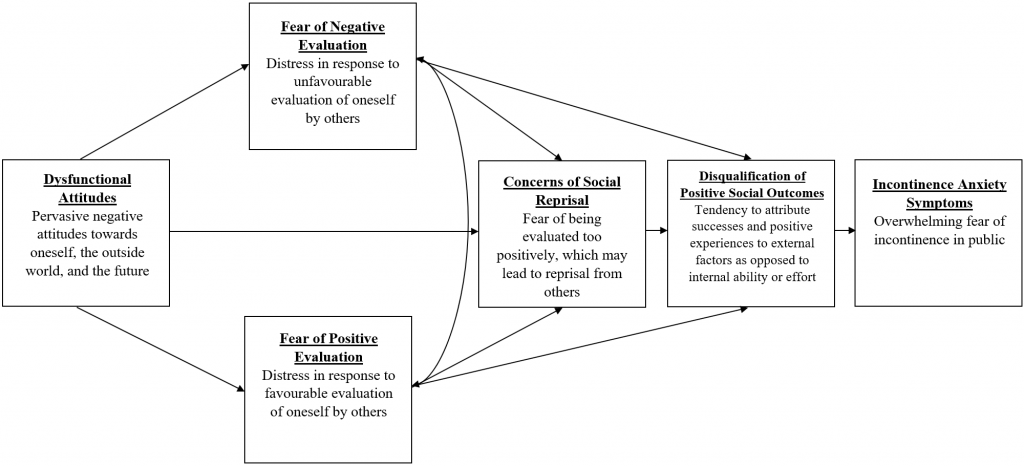Incontinence anxiety and social anxiety disorder
Currently, incontinence anxietyand social anxiety have been noted to contain similar features. Like social anxiety, individuals with incontinence anxietymay experience unhelpful thinking patterns where they fear being negatively evaluated by others, along with avoidance behaviours and coping strategies to reduce the probability of an episode of incontinence in public. Consistent with social anxiety, incontinence anxietysufferers may also pay more attentionto information indicative of scrutiny or negative evaluation.
As with social anxiety, individuals living with incontinence anxiety may experience unhelpful thinking patterns where they fear being negatively evaluated by others (e.g., “If have an accident people will see it and start laughing at me”), along with engaging in avoidance behaviours to reduce the probability and frequency of potential incontinence in public.
In 2019 Kuoch, Meyer, Austin, and Knowles undertook a study to explore if an established model of social anxiety (the bivalent fear of evaluation, see HERE) could be adapted and applied to predict incontinence anxiety symptoms. Several psychosocial factors were identified to predict incontinence anxiety symptoms (see below for pictorial presentation of the psychosocial factors found to predict incontinence anxiety symptoms):
- Dysfunctional attitudes (pervasive negative attitudes towards oneself, the outside world, and the future e.g., “I will only be happy if everyone likes me”)
- Fear of negative evaluation (distress in response to unfavourable evaluation of oneself by others e.g., “you should have got to the restroom before you made that mess”)
- Fear of positive evaluation (distress in response to favourable evaluation of oneself by others e.g., “I feel uneasy when I get praise from authority figures”)
- Concerns of social reprisal (fear of being evaluated too positively, which may lead to reprisal from others, e.g., “I get concerned others will ‘put me in my place’”)
- Disqualification of positive social outcomes (attributing successes and positive experiences to external factors as opposed to internal ability or effort e.g., thinking that one will only get along with people who are easy to talk to)

Study details: Kuoch, K. L. J., Meyer, D., Austin, D. W., &Knowles, S. R. (under review). Socio-cognitive processes associated with bladder and bowel incontinence anxiety: A proposed bivalent model.
Study abstract:The aim of this study was to examine whether the extended bivalent fear of evaluation model (extended BFOE) of Social Anxiety Disorder (SAD) could be used to explain bladder and bowel incontinence anxiety (BBIA). It was hypothesised that the relationship between dysfunctional attitudes (DAs) and BBIA would be mediated by fear of negative evaluation (FNE), fear of positive evaluation (FPE), concerns of social reprisal (CSR), and disqualification of positive social outcomes (DPSO). Three-hundred-and-seventeen undergraduate students (76.7% female; mean age = 31.07 years) completed a cross-sectional online study. A structural equation model (SEM) supported the proposed model (χ² p-value = .131, CMIN/df = 1.560, CFI = .996, TLI = .990, RMSEA = .042, SRMR = .0245) with significant relationships found between DAs and FNE (p < .001), DAs and FPE (p = .002), DAs and CSR (p = .007), FNE and CSR (p < .001), FNE and DPSO (p < .001), FPE and CSR (p < .001), FPE and DPSO (p < .001), CSR and DPSO (p < .001), BBBIPSS bladder and bowel with incontinence anxiety (p < .001). These results suggest that DAs, FNE, and DPSO are important contributory factors in BBIA. Given that FNE was the strongest mediator in the model, clinicians may find it advantageous to target FNE in treatment of incontinence-anxiety.
